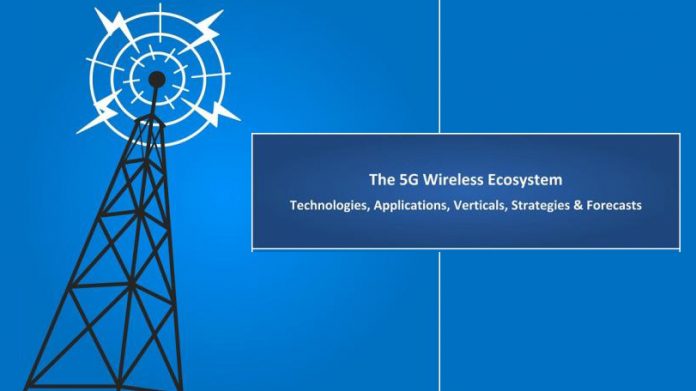While LTE and LTE-Advanced deployments are still underway, mobile operators and vendors have already embarked on R&D initiatives to develop so-called “5G” technology, with a vision of commercialization by 2020. 5G is essentially a revolutionary paradigm shift in wireless networking to support the throughput, latency and scalability requirements of future use cases such as extreme bandwidth augmented reality applications and connectivity management for Billions of M2M (Machine to Machine) devices.
Although 5G is yet to be standardized, vendors are aggressively investing in 5G development efforts with a principal focus on new air interface transmission schemes, higher frequency bands and advanced antenna technologies such as Massive MIMO and beamforming. With large scale commercial deployments expected to begin in 2020, we estimate that 5G networks will generate nearly $250 Billion in annual service revenue by 2025.
The “5G Wireless Ecosystem: 2016 – 2030 – Technologies, Applications, Verticals, Strategies & Forecasts” report presents an in-depth assessment of the emerging 5G ecosystem including key market drivers, challenges, enabling technologies, use cases, vertical market applications, spectrum assessment, mobile operator deployment commitments, case studies, standardization, research initiatives and vendor strategies. The report also presents forecasts for 5G investments and operator services.
Key Findings:
The report has the following key findings:
– Although 5G is yet to be standardized, vendors are aggressively investing in 5G development efforts with a principal focus on new air interface transmission schemes, higher frequency bands and advanced antenna technologies such as Massive MIMO and beamforming.
– Driven by regional, national government, mobile operator and vendor initiatives, we expect that over $6 Billion will be spent on 5G R&D and trial investments between 2015 and 2020.
– With large scale commercial deployments expected to begin in 2020, we estimate that 5G networks will generate nearly $250 Billion in annual service revenue by 2025.
– 5G networks are expected to utilize a variety of spectrum bands for diverse applications, ranging from established sub-6 GHz cellular bands to millimeter wave frequencies.
The report covers the following topics:
– 5G requirements, use cases and vertical market applications
– 5G market drivers and barriers
– Air interface and antenna technologies: new waveforms, millimeter wave radio access, MIMO, phased array antennas and beamforming
– Spectrum technologies: cognitive radio, spectrum sensing, aggregation and LSA (Licensed Shared Access)
– D2D (Device to Device) communications and self-backhauling networks
– Complimentary technologies for 5G: NFV (Network Functions Virtualization), SDN (Software Defined Networking), HetNet (Heterogeneous Networking), C-RAN (Centralized RAN), Cloud RAN, MEC (Mobile Edge Computing), drones and satellites
– Mobile operator commitments, case studies and 5G spectrum assessment
– 5G Standardization and research initiatives
– Competitive assessment of vendor strategies
– R&D, commercial infrastructure and operator service forecasts till 2030
Forecast Segmentation:
Market forecasts are provided for each of the following submarkets and their subcategories:
5G R&D Investments
– New Waveforms & Millimeter Wave Radio Access
– MIMO, Beamforming & Antenna Technologies
– Interference & Spectrum Management
– C-RAN, Virtualization & Other Technologies
5G Commercial Infrastructure Investments
– Distributed Macrocell Base Stations
– Small Cells
– RRHs (Remote Radio Heads)
– C-RAN BBUs (Baseband Units)
– Mobile Core
– Fronthaul & Backhaul Networking
5G Operator Services
Subscriptions
Service Revenue
Regional Segmentation
– Asia Pacific
– Eastern Europe
– Latin & Central America
– Middle East & Africa
– North America
– Western Europe
Key Questions Answered:
The report provides answers to the following key questions:
– How much will vendors and operators invest in 5G R&D commitments?
– What will be the number of 5G subscriptions in 2020 and at what rate will it grow?
– What will be the key applications of 5G networks?
– What trends, challenges and barriers will influence the development and adoption of 5G?
– Which regions and countries will be the first to adopt 5G?
– Will 5G networks utilize new spectrum bands?
– Who are the key 5G vendors and what are their strategies?
– Will 5G networks rely on C-RAN architecture?
– What are the prospects of millimeter wave technology for 5G radio access networking?
– What will be the impact of 5G on the M2M and IoT ecosystem?
– Will drone and satellite based communication platforms play a wider role in 5G networks?
List of Companies Mentioned:
The following companies and organizations have been reviewed, discussed or mentioned in the report:
– 3GPP (Third Generation Partnership Project)
– 5G Americas
– 5G Forum, South Korea
– 5G Lab (TU Dresden)
– 5G PPP (5G Infrastructure Public Private Partnership)
– 5GIC (5G Innovation Center, University of Surrey)
– 5GMF (Fifth Generation Mobile Communications Promotion Forum, Japan)
– 5GRUS
– Alcatel-Lucent
– Alpental Technologies
– América Móvil
– ARIB (Association of Radio Industries and Businesses)
– Ascenta
– AT&T Mobility
– Athena Wireless Communications
– ATIS (Alliance for Telecommunications Industry Solutions)
– AVC Networks Company








